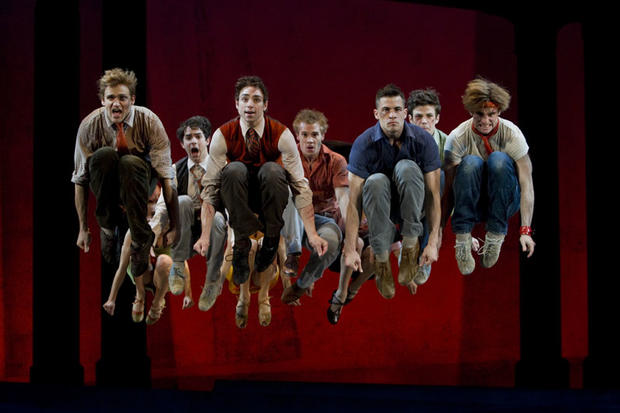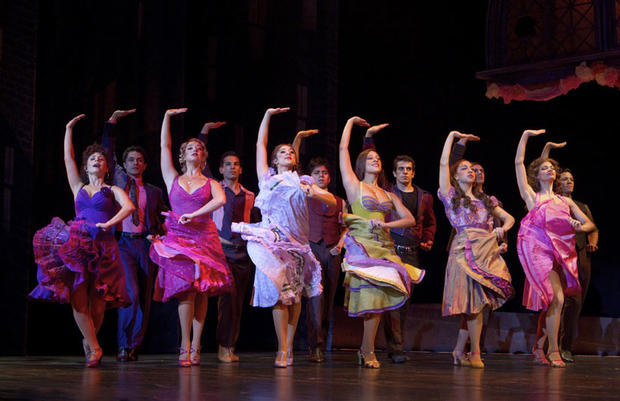Curiocity: 'West Side Story' Still Teems With Vitality
"Tonight." "Somewhere." "America." "Maria." "Cool."
West Side Story is a Broadway battleship with an endless artillery of showtune shells, not a single one of which fails to detonate.
Ain't nothing this hulking mass of brilliance can't withstand, even a blockbuster movie version that (10 predominately deserved Oscars aside) committed more than one or two injustices against the paired brilliance of composer Leonard Bernstein and choreographer Jerome Robbins, who were both working at the absolute apex of their powers here. (Lyricist Stephen Sondheim was on board, too, but I think you'd be hard pressed to say these were his best words.)
The play's brilliant concept -- to transpose William Shakespeare's Romeo & Juliet into the heart of America's melting pot during the height of the country's hysteria over juvenile delinquency -- was youth squared. Broadway was as much in its prime as the show's rival gangs the Jets and the Sharks were, and Robbins' angular, athletic dance moves (executed perfectly in Chuck Taylors) punctuated the musical's every brash edge.
Fads change, but youth -- arrogant, impetuous, crazy in love youth -- endures in a way that keeps West Side Story fresh and vital even as some of its immediately recognizable signposts (i.e. crouched snapping, switchblade rumbles, bottles of sody pop) have lapsed into the general tapestry of American kitsch. Just as Romeo & Juliet, properly staged, still resonates even as modern audiences find themselves all but drowning in iambic pentameter couplets that have become, through familiarity, clichés.
Ubiquity is such sweet sorrow, and I give the late Arthur Laurents (who wrote the book for West Side Story's original production) major props for daring to stare it down when he took the directorial reigns for the show's recent Broadway revival. Without digging too deep into the show's wiring, Laurents gave the apparatus subtle but crucial tweaks to keep it contemporary while retaining its now very distant 1950s setting.
Laurents, who passed away just a few months ago, must've recognized that the play's biggest age spot is the inequality by which the white Jets and their Puerto Rican rivals the Sharks are presented. The show-stopping number "America" aside, "them PRs" were arguably marginalized, supporting players. That doesn't exactly change in this reboot, but Laurents' choice to have the Sharks insist on speaking in Spanish gives them a privileged presence they never had before.
The touring version of Laurents' version directed by David Saint, which now arrives in Minneapolis for one hot minute (or week, rather), pulls in the reigns a bit from the Broadway version, which committed to full on Spanish-only in numbers like "Me Siento Hermosa" (i.e. "I Feel Pretty"). This version has a more magnanimous bilinguality, which provides for a new dynamic between the Sharks and their women, who insist on assimilation-minded English even as their hot-headed mates "Si" and "Por favor" their way through every tense encounter with the Jets.
At the center of the storm are Kyle Harris and Ali Ewoldt as Tony and Maria, scar-crossed lovers reaching for the stars from deep inside the urban jungle. Harris lands Tony/Romeo's awkward sensitivity effortlessly (you truly understand just whyTony dropped out of the Jets here). And Ewoldt's occasional lapses into snitty petulance as Maria/Juliet are kind of perfect. Though Ewoldt's performance may serve up some cognitive dissonance for everyone who is used to the Natalie Wood model Maria -- preternaturally centered and wise beyond her years -- it indeed stresses just how young this "craziest girl on the block" really is.
The only problem is that their respective styles as vocalists are so different that they do not suggest instant, love-at-first-sight chemistry, and their overtures sometimes end up one-sided. Harris's soft, throaty delivery is often devoured whole by Ewoldt's sharp, operatic tones. But both they and their surrounding company (including Michelle Aravena as Anita and Joseph J. Simeone as Riff) execute Bernstein's tricky, jazzy compositions fearlessly. No easy feat, considering the melody of, say, "Cool" seems almost wholly comprised of tritone intervals.
Laurents' changes did not extend to upending Robbins' choreography. Why would he? Iconic isn't the word for those mambos and pas de deux-es. Canonical, more like. And this company brings them back to vibrant life. The dances at the gym, the violent, stabbing rumble, the wistful "Somewhere" ballet -- all raise goosebumps. And a lascivious, downright lewd rendition of the crowd-pleasing "Gee, Officer Krupke" (which brings new meaning to the word "jerk") brings down the house to such an extent I don't mind its placement in the second act. (Thematically, I've always thought it made more sense in the movie version, before the two deaths at the rumble bring everyone down.)
To my tastes, West Side Story is the greatest Broadway musical ever written, and even though this revival has backed down from some of Laurents' more extreme revisions, the battleship continues to sail forth, undefeated.





